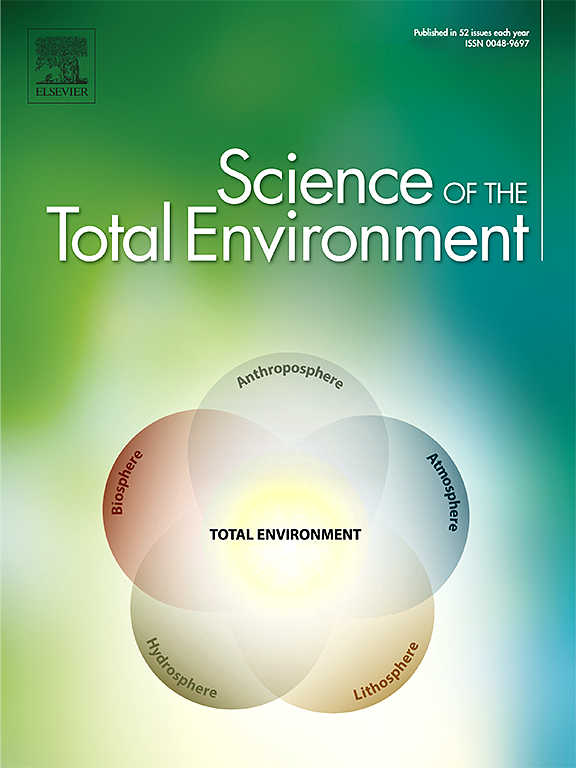Unveiling the role of saltmarshes as coastal potassium sinks: A perspective from porewater-derived potassium exchange
IF 8.2
1区 环境科学与生态学
Q1 ENVIRONMENTAL SCIENCES
引用次数: 0
Abstract
Saltmarshes serve as repositories for various metal species, primarily due to vegetation removal and mineralization processes. However, the significance of potassium (K), one of the three major nutrients (nitrogen, phosphorus, and K) essential for plant growth, has often been overlooked, particularly in the context of saltmarshes where the mechanisms of K transport via porewater exchange remain poorly understood. To address this knowledge gap, we conducted field observations and laboratory analysis, and developed a 222Rn mass balance model to quantify K fluxes via porewater exchange under physical, biological, and anthropogenic drivers. Our findings revealed that saltmarshes function as highly effective K sinks, with porewater exchange rates ranging from 12.2 to 44.5 cm d−1 and related K fluxes spanning −122 to −1260 mmol m−2 d−1. Interestingly, wet season K fluxes were found to be ∼4.3 times higher than those observed during the dry season. Moreover, we observed that wet season K fluxes peaked during the neap tide, while dry season K fluxes reached their maximum during the spring tide. This suggests that K transport via porewater exchange is influenced by both crab burrow bioturbation and spring-neap exchange mechanisms. In addition, anthropogenic activities, such as biomass burning, also impact K dynamics in addition to physical and biological drivers. Overall, our study highlights the pivotal role of porewater exchange in driving the K cycle within saltmarshes. This exchange mechanism not only facilitates plant growth but also contributes to important mineralogical processes, including cation exchange and reverse weathering, occurring within the saltmarsh ecosystems. By shedding light on the K cycle in saltmarshes, our research contributes to a better understanding of the functioning of coastal wetlands and their implications for the oceanic K budget.

揭示盐沼作为沿海钾汇的作用:从孔隙水衍生钾交换的角度。
盐沼作为各种金属物种的储存库,主要是由于植被的移除和矿化过程。然而,植物生长必需的三种主要营养物质(氮、磷和钾)之一钾(K)的重要性经常被忽视,特别是在盐沼中,钾通过孔隙水交换的运输机制仍然知之甚少。为了解决这一知识差距,我们进行了实地观察和实验室分析,并开发了222Rn质量平衡模型,以量化物理、生物和人为驱动下通过孔隙水交换的K通量。研究结果表明,盐沼具有高效的钾汇功能,孔隙水交换速率为12.2 ~ 44.5 cm d-1,相关钾通量为-122 ~ -1260 mmol m-2 d-1。有趣的是,雨季的钾通量是旱季的4.3倍。此外,湿季K通量在小潮期间达到峰值,而干季K通量在大潮期间达到最大值。这表明通过孔隙水交换的钾转运受到蟹洞生物扰动和春-小潮交换机制的双重影响。此外,除了物理和生物驱动因素外,人为活动(如生物质燃烧)也会影响钾的动态。总的来说,我们的研究强调了孔隙水交换在驱动盐沼中钾循环中的关键作用。这种交换机制不仅促进了植物的生长,而且有助于盐沼生态系统中发生的重要矿物学过程,包括阳离子交换和反向风化。通过揭示盐沼中的钾循环,我们的研究有助于更好地理解沿海湿地的功能及其对海洋钾收支的影响。
本文章由计算机程序翻译,如有差异,请以英文原文为准。
求助全文
约1分钟内获得全文
求助全文
来源期刊

Science of the Total Environment
环境科学-环境科学
CiteScore
17.60
自引率
10.20%
发文量
8726
审稿时长
2.4 months
期刊介绍:
The Science of the Total Environment is an international journal dedicated to scientific research on the environment and its interaction with humanity. It covers a wide range of disciplines and seeks to publish innovative, hypothesis-driven, and impactful research that explores the entire environment, including the atmosphere, lithosphere, hydrosphere, biosphere, and anthroposphere.
The journal's updated Aims & Scope emphasizes the importance of interdisciplinary environmental research with broad impact. Priority is given to studies that advance fundamental understanding and explore the interconnectedness of multiple environmental spheres. Field studies are preferred, while laboratory experiments must demonstrate significant methodological advancements or mechanistic insights with direct relevance to the environment.
 求助内容:
求助内容: 应助结果提醒方式:
应助结果提醒方式:


